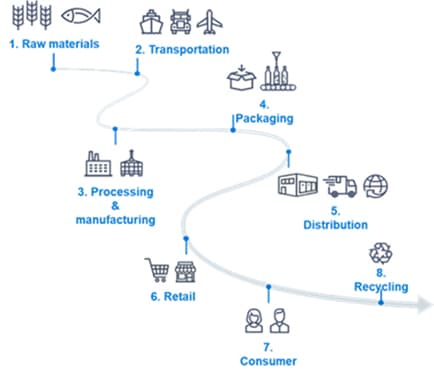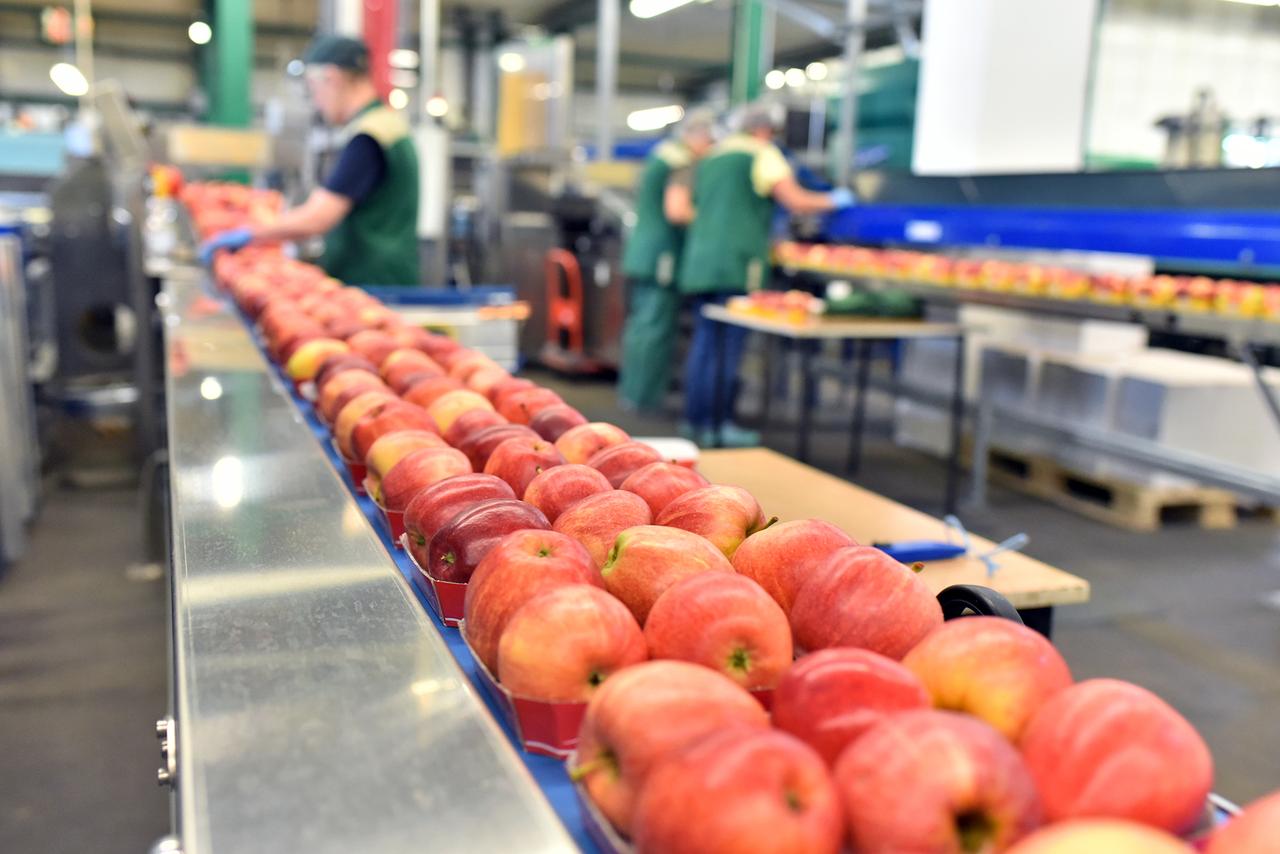inputs and outputs
supply chain
Maintaining
Technology helps ensure integrity, safety and transparency in supply chain I/Os
For food and beverage processors, supply chain management covers a lot of territory.
For instance, Ted Combs, an industry principal for CPG and Food & Beverage at AVEVA, says it is about optimization at all stages and providing end-to-end value for the business. From a procurement perspective, that might include ensuring the right ingredients are sourced and received at the right time. “It’s about creating a system that promotes traceability of ingredients and materials, supports recipe management and prioritizes quality,” he says.
Supply chain management also is critical to helping companies manage inventory and packaging, scheduling, and costs. A company wants to know that they have the right items onsite at the right time for the right cost and that the products are delivered to customers while meeting quality specifications.
“It starts with the ingredients, extends to manufacturing and packaging processes, and ultimately through shipping and distribution to customers and distributors,” Combs says. “It’s a critical part of business, and digital software can help ensure each stage is designed and operated efficiently in a way that reduces burdens and creates value.”
Sharon Spielman, Senior Editor
Marcel Koks, industry and solution strategy director for Food & Beverage at Infor, notes that the food and beverage industry experienced a number of supply chain disruptions during the last year, including Brexit, trade wars, the pandemic and more recently, the blocked Suez Canal. “And these will not be the last disruptions that we will see,” he says. “Demand will shift back from the grocery stores to restaurants, but will it return to the pre-pandemic levels? Harvests can fail in some regions because of drought and countries can be shut down because of plagues. There are many uncertain factors.”
Compliance is another important consideration for a food processor, Koks says. Not all available ingredients are suitable for all demand; some customers exclude some countries of origin or growers, or ask for other certificates. “To cope with these changes, visibility of the supply chain from farm to fork is key, so that very quickly alternative scenarios can be evaluated and decisions can be made in planning and operations. What has become clear is that digital leaders are more agile and outpace the competitors that simply need too much time to get a clear picture from multiple legacy or paper-based systems,” he says.
The next level of supply chain visibility is supply chain transparency, which is about sharing the information in the supply chain, Koks adds. This has multiple purposes, like collaborating in the cold chain to minimize food safety risks and maximize shelf lives, or work more closely with the farmers to reduce food waste.
John Rowley, vice president of the Global Food Division at NSF International, believes that the global supply chain for food and beverages is a complex one. “Food and beverage processors often see themselves as positioned towards the end of the supply chain, as they can be either a direct source to the consumption point at retail or foodservice, or removed from that point by only a distribution center,” he says. “Hence, they consider the logistics to move their product one step forward, and the sourcing of their raw materials one step backward.”

The farm-to-fork value chain has several inputs and outputs throughout the process. Graphic courtesy of AVEVA

“Simply put, if plants aren’t effectively maintained it can lead to inefficiencies and added costs.”
— Ted Combs, industry principal for CPG and Food & Beverage at AVEVA
The supply chain is actually an intricate web from the primary producers, he says, generally at the farm level, through to various levels of processors, to stops at one or more distribution centers, before the finished product lands at its final destination at retail or restaurant. “Add in the transport of raw materials and products globally, and the management of the food and beverage supply chain becomes an even more momentous task,” Rowley says.
Managing inputs and outputs
When it comes to the inputs and outputs of the supply chain, processing plants must maintain them or face the consequences.
“Simply put, if plants aren’t effectively maintained it can lead to inefficiencies and added costs,” says Combs. “Food safety, for instance, is no trivial matter. If an organization doesn’t have complete visibility into sourced ingredients and finished products, and how they are handled throughout the supply chain, then they run the risk of unsafe products, excessive waste and potential recalls.”

Proper supply chain management helps processors ensure ingredients and materials meet quality standards and production deadlines. Photo courtesy of Getty Images/Industryview
This could cause issues that extend beyond financial and impact brand equity and reputation. “A poorly maintained plant is a financial burden and can lead to higher costs, missed customer service targets and put a company’s market share risk,” he says.
Koks adds that food safety incidents can be very costly to a business and negatively impact consumer trust and brand value. “There’s absolutely no question that being able to undertake a recall very quickly and targeted is crucial to minimize food safety issues and damage to the brand,” he says. “However, many food manufacturers do not have a completely digital track and trace in place. Some information is coming from their transactional systems, but it’s not very granular and quality details have to be looked up in other systems or even from paper registrations.”

“Obviously, it’s important to capture everything that happens in the goods flow, like the lot number of the ingredients being used to produce a pallet of the finished product.”
— Marcel Koks, industry and solution strategy director for Food & Beverage at Infor
It takes too much time to analyze the incident based on this disjointed information, resulting in bigger recalls without really knowing the root cause, Koks says. “Having detailed track and trace records, including source information, processing details and quality test results in one single digital platform really makes a huge difference during a food safety crisis.”
Rowley points out that even before the world had to contend with the spread of COVID-19, knowledge and action plans related to raw material inputs and product outputs were important. “Accurate planning is essential, and many food and beverage organizations utilize just-in-time (JIT) production scheduling to keep inventory levels and costs low,” he says. However, that model is not without risks—as potential surges and declines in demand for particular items can upset the delicate balance of the JIT approach.
“With the pandemic, many processors found themselves experiencing surges and declines in a way not seen previously. Rapid, panicked responses (particularly in the early weeks and months) on the part of consumers meant that some items, such as toilet paper and cleaning products, disappeared from store shelves while outbreaks in meat processing plants forced closures that resulted in an overabundance of animals languishing at farms,” Rowley adds.

“Processors must understand what is in place at points further back and ahead.”

